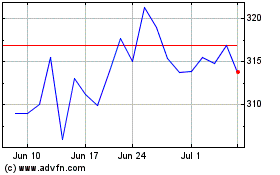Recorded Music Revenue Hits $12 Billion in 2020 Amid Pandemic Streaming Boom
February 26 2021 - 2:00PM
Dow Jones News
By Anne Steele
Sales of recorded music grew 9.2% last year to $12.2 billion as
subscriptions to streaming services reached new highs during the
Covid-19 pandemic.
The past year marked the music industry's fifth consecutive year
of growth thanks to streaming, which accounted for 83% of total
revenue, according to a report from record company trade group the
Recording Industry Association of America. Revenue generated from
music licenses to social media and fitness apps also picked up
during the last year.
The pandemic lockdowns were momentous for at-home streaming
entertainment services in 2020. With almost no live concerts,
limited capacity at sporting events and closed movie theaters
consumers tuned into music-streaming apps, and flocked to social
apps like Instagram, and TikTok and at-home fitness apps like
Peloton, which heavily rely on music to engage users. drive
engagement.
Subscriptions to on-demand streaming services offered by Spotify
Technology SA, Apple Inc. and others grew to 75.5 million from 60.4
million in 2019, the biggest ever increase in a single year. The
streaming category, which also includes ad-supported on-demand
services, such as YouTube, Vevo and Spotify's ad-supported tier,
streaming radio services such as Pandora and SiriusXM, as well as
music licenses for streaming fitness services like Peloton,
generated $10.1 billion in 2020, up 13.4% from the previous
year.
"These services are largely music-powered -- whether it's TikTok
dances, skateboarding dreams, or Instagram people-watching, the
'most followed' lists for all these services and platforms are
overwhelmingly made up of artists and music creators," said RIAA
Chief Executive Mitch Glazier.
RIAA's data includes Peloton and Facebook, which owns Instagram,
but it doesn't include TikTok.
The music industry's fortunes started to turn around in 2016,
when the growth from streaming services began to outweigh a 15-year
decline in CD sales amid rampant online piracy. Revenue is still
below, but closing in on, its 1999 peak of $14.6 billion.
Last year, sales of physical music products were flat at $1.1
billion. Revenue from sales of vinyl -- up 29% to $626 million --
surpassed revenue from CDs for the first time since 1986, though it
still only accounted for 5.2% of overall revenue. Digital download
sales fell 18% to $674 million, and accounted for just 6% of total
revenue in 2019.
A decline in advertising revenue during the pandemic dragged on
revenue from ad-supported on-demand streaming services such as
Alphabet Inc.'s YouTube and Spotify's free service, which saw 17%
year-over-year growth to $1.2 billion. The category saw nearly 30%
growth in each of the prior three years.
Write to Anne Steele at Anne.Steele@wsj.com
(END) Dow Jones Newswires
February 26, 2021 13:45 ET (18:45 GMT)
Copyright (c) 2021 Dow Jones & Company, Inc.
Spotify Technology (NYSE:SPOT)
Historical Stock Chart
From Oct 2024 to Nov 2024

Spotify Technology (NYSE:SPOT)
Historical Stock Chart
From Nov 2023 to Nov 2024
